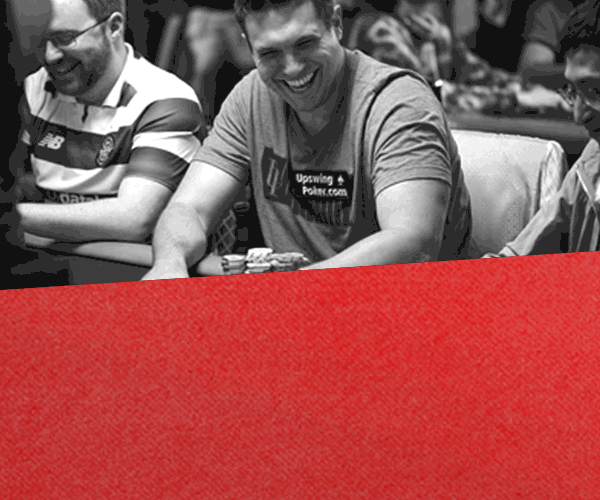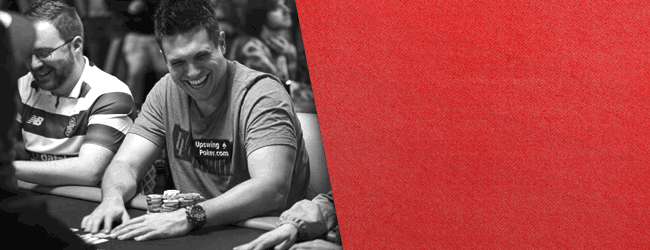5 Not-So-Easy River Spots Explained By A Game Theory Expert
Discussing hands with friends is a great way to get better at poker.
Now, imagine if one of your friends was top 6-max player and game theory expert Fried Meulders. Discussing hands with him would be an incredible way to get better at poker.
Fried is a successful regular in the ultra-tough Zoom cash games on PokerStars, where he puts up impressive numbers like this:
Fried “mynameiskarl” Meulders’ past 100,640 hands on PokerStars
In this article, Fried provides his expert analysis on 5 hands played by members of The Upswing Lab. This should give you a pretty good idea of what it’s like to have your own play put under the microscope by a top pro.
Let’s get into the hands and Fried’s words of wisdom:
Hand 1 — Top pair top kicker facing an overbet
Our first hand was played Lab member Greg P. who submitted it to our private strategy group for review.
$0.25/$0.50. 5-Handed. $53 Effective Stacks.
Hero is dealt A♥ Q♠ in the SB
3 folds. Hero raises to $1.25. BB calls.
Flop (Pot: $2.50): 9♠ Q♦ 4♦
Hero bets $1.78. BB raises to $5.04. Hero calls.
Turn (Pot: $12.58) 5♠
Hero checks. BB bets $8.97. Hero calls.
River (Pot: $30.52): 5♥
Hero checks. BB bets $38.03 and is all-in. Hero ?
Greg’s Notes
The stats for the opponent in the BB are as follows:
- VPIP: 25%
- PFR: 18%
- 3-bet: 9%
- Fold to 3-bet: 60%
- Fold to steal: ~70%
This player is a regular that 3-bets me quite aggressively and doesn’t fold much to me in pre-flop situations. Post-flop, the player has no major leaks and is not easy to play against.
They snap-shoved on this river. Thoughts?
Fried’s Thoughts
I’ll show you the way I’d think about the hand in order to reach my own decision.
The first thing I’d do against a balanced/strong opponent (as you’ve implied the Villain to be) is work out the minimum defending frequency (MDF) in this spot. This frequency determines how much I need to be calling to prevent our opponent from profitably bluffing with any two cards on a brick river.
The formula to work this out is as follows:
(pot-size / (bet-size + pot-size)) x 100 (to get your frequency expressed as a percentage).
Against this slight overbet, the MDF works out at 44.5%, meaning we need to call down at least 44.5% of the time against a balanced opponent to prevent getting exploitatively bluffed on the river.
It’s worth noting that against a player that might not have enough bluffs here, I’ll deviate from this MDF and fold a bit more.
Next, I’d think about my range on this river given the prior action and determine which portion of my range I need to call down with. This will be influenced by how my specific hand blocks the ranges of my opponent:
- When I block my opponent’s value range and don’t block their bluffs, I am more inclined to call
- If I don’t block my opponent’s value range and block their bluffs, I’ll likely fold
In this specific example, we are blind versus blind in a single-raised-pot, meaning that ranges are wide. AQ is definitely high enough in our range here to justify calling.
This is especially true when you consider how our blockers function:
- In terms of value, we block our opponent from having Q9–a value hand that would likely be played this way
- A♥Q♠ doesn’t block the diamond flush-draw which our opponent can be raising and firing with after missing
- We don’t block the potential straight-draws (such as JT, KT and KJ)
The draws listed above are combos that might be turned into bluffs on the river, and by not blocking them we make it more likely that our opponent has this type of hand.
A closing word on using MDF in this spot: you don’t need to stick to this frequency on bad rivers. On cards that are bad for our range and good for the flop-raising, turn-barrelling range of our opponent, we can viably fold more frequently than the MDF indicates.
Lab members only: Check out the original post and Fried’s thoughts here
(Note: Take your poker skills to the next level with The Upswing Lab — a poker training course updated monthly by Doug Polk, Ryan Fee, Fried Meulders and Parker Talbot. Click here or below to learn more.)

Hand 2 — Bluff-raising with the nut flush blocker
This hand was submitted by Lab member Camilo K.
$0.05/$0.10 Zoom. 6-Handed. $18.10 Effective Stacks.
Hero is dealt A♥ 9♣ on the BTN
3 folds. Hero raises to $0.30. SB calls. bb folds.
Flop ($0.70): 9♦ 3♥ 4♥
SB checks. Hero bets $0.47. SB raises to $1. Hero calls.
Turn ($2.70): K♥
SB bets $1.30. Hero calls.
River ($5.30): T♠
SB bets $2. Hero raises to $6.05. sb folds.
Camilo’s Notes
Is this too fancy?
Fried’s Thoughts
As played, turning your hand into a bluff definitely makes sense given that you block the nut flush. However, I’d suggest using a bigger size on this river-raise.
In this exact spot, your sizing gives your opponent a very good price on a call–they are risking $4.05 to win $13.35. This means that they only need to be good around 23% of the time when calling, which gives our opponent a fairly easy spot with a large part of their range.
By using a larger size with our nut flush blocker, we get to generate more fold-equity when we are bluffing, and get more value from our opponent when we are called and turn over the nuts.
Lab members only: Check out the original post and Fried’s thoughts here
Hand 3 — To bluff-shove or not to bluff-shove
This hand was submitted by Lab member Dan A.
$0.25/$0.50 Winning Poker Network. 6-Handed. $51.50 Effective Stacks.
Hero is dealt 9♦ 5♦ on the BTN
3 folds. Hero raises to $1.13. sb folds. BB calls.
Flop ($2.51): Q♠7♣9♣
BB checks. Hero checks.
Turn ($2.51): 8♥
BB checks. Hero bets $1.65. BB raises to $5.50. Hero calls.
River ($13.51): 3♥
BB bets $11.50. Hero ?
Dan’s Notes
Thoughts on a river shove here?
Fried’s Thoughts
A river shove should be avoided here. We need to think what we would be jamming this river with for value and build our bluffs around that.
On this runout, the main hands we’d be jamming for value are JT and 56. This means that we want to bluff with hands that have a T or a 6 in them, as these block the most straight combos that our opponent will be calling us down with.
It’s also better to check back the turn with 9♦ 5♦ on this turn. Our hand has some showdown value along with a straight-draw (albeit a weak one).
Betting for value doesn’t make much sense–we aren’t often going to be getting called by worse. By checking back, we also avoid putting ourselves in an awkward spot like this one where we get raised and are forced to fold our equity. With position on our side, we can check back the turn and hope to get to a cheap showdown.
Lab members only: Check out the original post with Fried’s thoughts here
Hand 4 — Middle pair facing probe and barrel
This hand was submitted by Lab member Jesse F.
Live $5/$10. 6-Handed. $1000 Effective Stacks.
Hero is Q♣ 7♣ in the CO
2 folds. Hero raises to $35. btn folds. SB calls. bb folds.
Flop ($80): A♠Q♥4♦
SB checks. Hero checks.
Turn ($80): 5♠
SB bets $55. Hero calls.
River ($190): 9♥
SB bets $90. Hero ?
Fried’s Thoughts
This is a borderline call; folding is understandable.
From a theoretical perspective, a SB flatting range versus a large open size (3.5x) is expected to be fairly tight. However, opening sizes and player tendencies can vary pretty drastically in live games, so properly ranging your opponent here is difficult.
If you have any additional information available about the bluffing tendencies of your opponent, use this to make a better-informed decision.
- Against a loose opponent, I’d make this call given the size and our exact hand (we have clubs which don’t block any flush-draw combos on this board)
- Against a tight player that bluffs less frequently, laying it down makes more sense – we have stronger Ax and Qx combos in our range that we can call with instead
Lab members only: Check out the original post and Fried’s thoughts here
Hand 5 — An unorthodox bluff line
This hand was submitted by Lab member Marco M.
$0.25/$0.50. 4-Handed. $51 Effective Stacks
Hero is dealt K♣J♥ in the SB
co folds. BTN raises to $1.25. Hero raises to $4.50. bb folds. BTN calls.
Flop ($9.50): 2♣ 3♠ 9♥
Hero checks. BTN checks.
Turn ($9.50): Q♣
Hero bets $5.50. BTN calls.
River ($20.50): 8♣
Hero checks. BTN bets $14. Hero raises to $56.50 and is all-in.
Marco’s Notes
Is this line too aggressive?
Fried’s Thoughts
On this board, I’d c-bet the flop most of the time, bet the turn and bet the river.
We don’t have any showdown value on the flop, so the plan is to bet with the intention of comfortably barrelling on any club, Q, K or T.
In terms of sizing, we’d go smaller on the flop (~1/3 pot), and use a size on the turn that sets up a shove on favourable river cards.
From a hand selection standpoint, bluffing with this combo (K♣J♥) indeed makes sense, as we block the nut straight (JT) and block stronger flushes with our K♣ that complete on the 8♣ river.
However, the main issue with the line taken is that you’re expected to be betting your value hands on this river. None of your flush, JT or 99 combos block your opponent’s stronger Qx hands that might call us down. Given that these value hands should be betting, we need to also be betting here with some bluffs–rather than check-raising–to balance this range.
Lab members only: Check out the original post and Fried’s thoughts here
Final Thoughts
It can be intimidating to open yourself up to criticism by sharing a hand with others, but it is definitely a habit worth doing if you want to improve your game.
Getting other perspectives on your actions will help you to think about the merits of different strategies, with members working together to try and find the best one. This makes study-groups a very valuable learning tool–especially when you’ve got the likes of Fried, Doug and Ryan to give you feedback.
Note: Study poker with step by step instructions and examples for a huge number of topics in The Upswing Lab. Click here or below to learn more.

Read more from Upswing Poker:
- Make sure you don’t believe any of these 5 Tournament Myths Way Too Many Players Believe
- Defend your big blind like a pro with Optimal Big Blind Defense: Tournaments vs Cash Games
- Learn how to boost your win-rate in preflop multiway pots in The Ultimate Guide to Preflop Multiway Pots
- Read more about game theory in poker